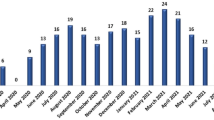Abstract
Medical equipment is used in the diagnostic, monitoring and therapy, offering numerous benefits to the patients. However, these devices’ technical factors and the human aspects can produce adverse events, which may cause severe consequences for the patients. Therefore, it is crucial to provide means to mitigate these situations by improving safety in equipment use. Thereby, our objectives are to present to the scientific community the main alerts, dangers and failures related to medical equipment use and ways to attenuate them. For that purpose, we performed an analysis of adverse events reported for some medical equipment in the Food Drugs Administration (FDA/USA) and the Brazilian Health Surveillance Agency (ANVISA) databases, since 2016. Finally, we classified the events into different categories, according to similarity. The results show a total of 3100 cases registered in the FDA for the equipment at the study and 75 cases in ANVISA for two of this equipment. Based on the list of the top ten health hazards (2016–2020) provided by the Emergency Care Research Institute (ECRI) we were able to understand which equipment most offer hazards and the main ways to mitigate them. Overall, we found that the risks are common to medical devices, so the best way to deal with adverse events is prevention, through good maintenance and medical staff training for dealing with them.
Access this chapter
Tax calculation will be finalised at checkout
Purchases are for personal use only
Similar content being viewed by others
References
ANVISA. RDC number 02 (2010) Gerenciamento de tecnologias em saúde em estabelecimentos de saúde
Gao X et al (2019) A hazard analysis of class I recalls of infusion pumps. JMIR Hum Fctors. https://doi.org/10.2196/10366
Data Mining at the Center for Devices and Radiological Health at https://www.fda.gov/science-research/data-mining/data-mining-center-devices-and-radiological-health
Medical Device Reporting (MDR): How to Report Medical Device Problems at https://www.fda.gov/medical-devices/medical-device-safety/medical-device-reporting-mdr-how-report-medical-device-problems
OpenFDA at https://www.fda.gov/science-research/health-informatics-fda/openfda
Pham JC et al (2016) Ventilator-related adverse events: a taxonomy and findings from 3 incident reporting systems. Respir Care. https://doi.org/10.4187/respcare.04151
Infusion Pumps at https://www.fda.gov/medical-devices/general-hospital-devices-and-supplies/infusion-pumps
Automated External Defibrillators at https://www.fda.gov/medicaldevices/cardiovasculardevices/automated-external-defibrillators-aeds
Golpaygani AT, Movahedi MM, Reza M (2017) A study on performance and safety tests of defibrillator equipment. J Biomed Phy Eng
Bonafide CP et al (2017) Video analysis of factors associated with response time to physiologic monitor alarms in a children’s hospital. JAMA Pediatr. https://doi.org/10.1001/jamapediatrics.2016.5123
Crispi CP et al (2018) Hemostasis with the ultrasonic scalpel. JSLS. https://doi.org/10.4293/JSLS.2018.00042
Schabacker M (2018) Awareness alone won’t improve medical device safety. ECRI at https://www.ecri.org/press/improve-medical-device-safety
ECRI Institute Top Ten Technology Hazards for 2018. Health Devices 2017 November
ECRI Institute Top Ten Technology Hazards for 2016. Health Devices 2015 November
ECRI Institute Top Ten Technology Hazards for 2017. Health Devices 2016 November
ECRI Institute Top Ten Technology Hazards for 2019. Health Devices 2018 November
ECRI Institute Top Ten Technology Hazards for 2020. Health Devices 2019 November
Evans RS et al (2005) Enhanced notification of critical ventilator events. J Am Med Inf Assoc. https://doi.org/10.1197/jamia.M1863
Ruppel H, Funk M, Whittemore R (2018) Measurement of physiological monitor alarm accuracy and clinical relevance in intensive care units. Am J Crit. Care. https://doi.org/10.4037/ajcc2018385.
Peng M et al (2013) The ultrasonic harmonic scalpel for circumcision: experimental evaluation using dogs. Asian J Androl. https://doi.org/10.1038/aja.2012.67
Ferri E et al (2013) Harmonic scalpel versus conventional haemostasis in neck dissection: a prospective randomized study. Int J Surg Oncol. https://doi.org/10.1155/2013/369345
Otani M, Machado WV (2008) A proposta de desenvolvimento de gestão da manutenção industrial na busca da excelência ou classe mundial. Revista Gestão Industrial
ABNT, NBR 5462 (1994) Confiabilidade e Mantenabilidade
ABNT, NBR 15943 (2011) Diretrizes para um programa de gerenciamento de equipamentos de infraestrutura de serviços de saúde e de equipamentos para a saúde.
ISO17025 (2017) Requisitos gerais para a competência de laboratórios de ensaio e calibração
Acknowledgements
The authors thank CAPES and CNPq for their scholarships and UFES for technical and scientific support.
Conflict of Interest
The authors declare that they have no conflict of interest.
Author information
Authors and Affiliations
Editor information
Editors and Affiliations
Rights and permissions
Copyright information
© 2022 Springer Nature Switzerland AG
About this paper
Cite this paper
de Souza, J.C. et al. (2022). Evaluation of Adverse Events Recorded in FDA/USA and ANVISA/Brazil Databases for the Medical Equipment: Pulmonary Ventilators, Defibrillators, Infusion Pumps, Physiological Monitors and Ultrasonic Scalpels. In: Bastos-Filho, T.F., de Oliveira Caldeira, E.M., Frizera-Neto, A. (eds) XXVII Brazilian Congress on Biomedical Engineering. CBEB 2020. IFMBE Proceedings, vol 83. Springer, Cham. https://doi.org/10.1007/978-3-030-70601-2_314
Download citation
DOI: https://doi.org/10.1007/978-3-030-70601-2_314
Published:
Publisher Name: Springer, Cham
Print ISBN: 978-3-030-70600-5
Online ISBN: 978-3-030-70601-2
eBook Packages: EngineeringEngineering (R0)




